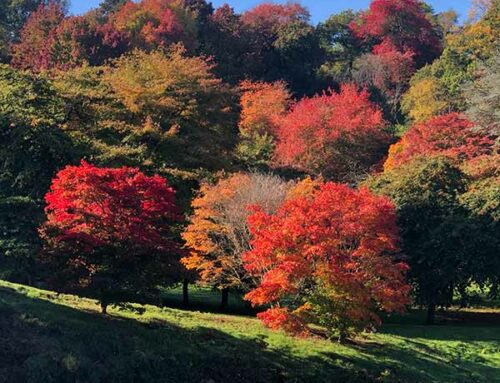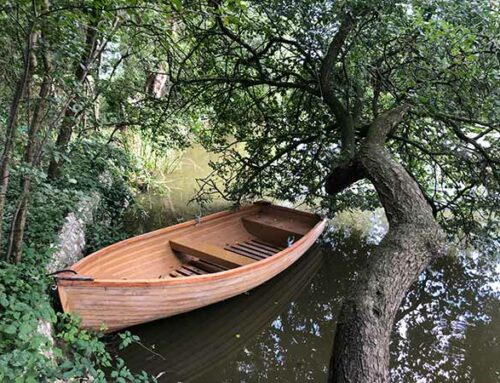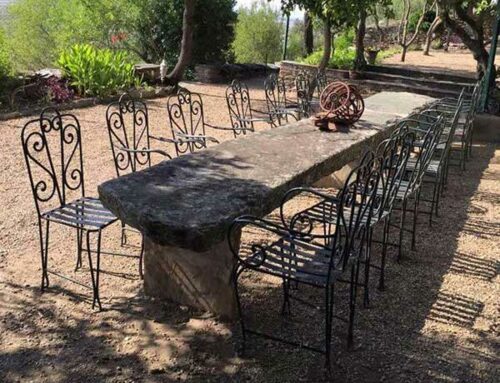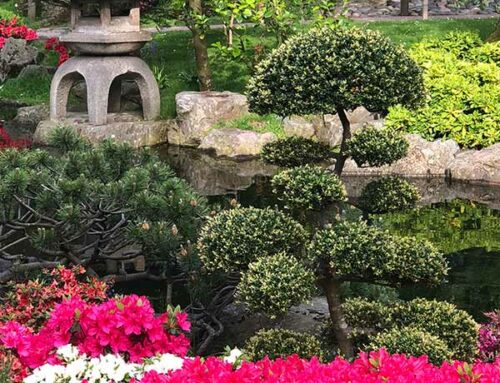If you’ve ever wondered what pleached trees are, specifically pleached fruit trees, how they differ from espaliers and fan-trained trees, or what on earth a hedge-on-stilts is, you’ll find all the answers here. If we’ve missed anything drop us a line or call and we’ll do our best to help.
What Is A Pleached Tree?
Pleached trees have a clear single trunk topped with a formal boxed crown. Pleached tree crowns are trained on flat bamboo frames by tying in young whippy branches and cutting off the excess. As the tree matures the flat crown fills out into a square. Pleached trees look modern but they’re an age-old tradition stretching back as far as the medieval period. Illustrations show rows of pleached trees were used to create shady arbours, walkways, tunnels, and arches to keep the elements at bay in gardens. And just for interest, the term ‘pleach’ or ‘plesh’ is a Middle English verb which means ‘to layer’. Just wait for that to pop up on the pub quiz!
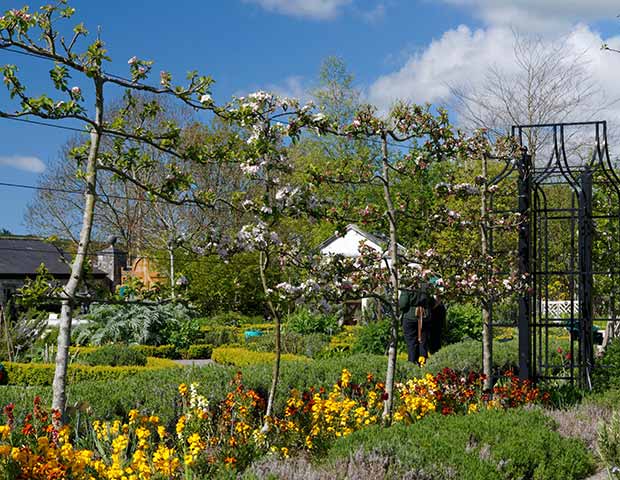
Pleached Fruit Trees laden with spring blossom
So What Is A Pleached Fruit Tree?
Any type of tree can be pleached. Pleached fruit trees have clear trunks with a square crown that bears fruit. We stock many different varieties of pleached fruit trees.
How about a pleached Victoria Plum tree or a pleached Conference pear? Both are very popular trees in the UK and fruit reliably. Of course, we can’t forget everyone’s favourite – the apple tree. Here’s a pleached Cox’s Orange Pippin a traditional heritage eating apple you can munch straight from the branch.
If you want to encourage pollinators and birds to your garden, fruit tree blossom is an open invitation. Birds especially love a crab apple. We recommended a hardy pleached MalusRudolph.
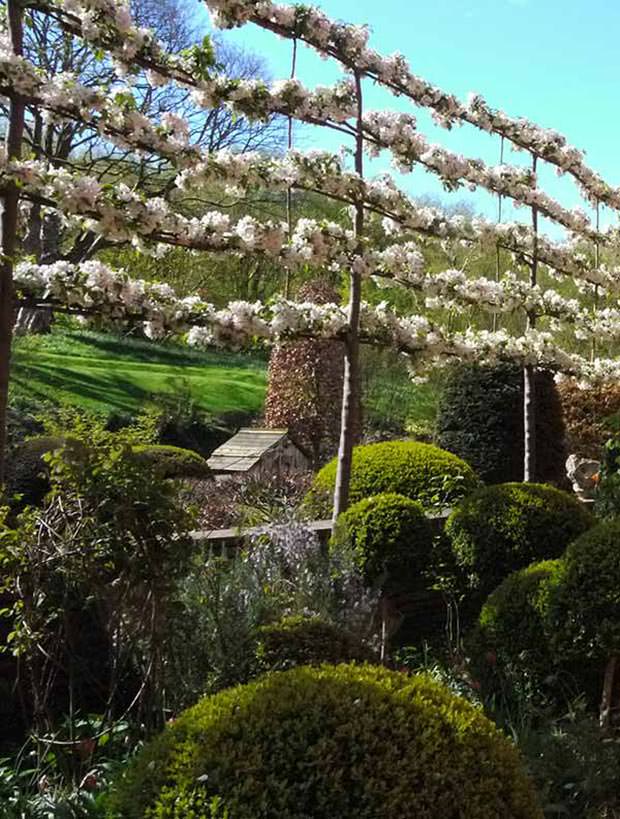
Pleached Crab apple trees will encourage pollinators and birds to your garden.
What’s The Point of a Pleached Tree?
The main reason people want pleached trees is to create privacy. You can’t beat a row of pleached fruit trees, or even a single strategically placed tree if you suffer from nosy neighbours in the summer. They’re a great choice for compact gardens too. Smaller gardens cry out for trees as they bring height and interest, but trees can get large and unmanageable. Pleached trees have restricted roots in line with the crown so they better suit smaller outdoor spaces.
When you choose pleached fruit trees you more than double the fun because they create privacy, bring dappled summer shade, encourage pollinators, AND deliver fresh delicious fruit to your back door.
How Do Pleached Fruit Trees Create Privacy?
The clear trunk of a pleached fruit tree stands in front of the fence and its square crown adds a few extra metres of height. It’s no wonder they’re dubbed a hedge-on-stilts. Think of a pleached fruit tree as an extension to the top of your fence line. One you don’t need planning permission for.
If you have year-round nosy neighbours, or you’re fed up with someone else’s bedroom window, it’s worth considering an evergreen pleached tree such as the always cheerful pleached Olive Trees. Pleached fruit trees are generally deciduous, so they lose their foliage in the winter months
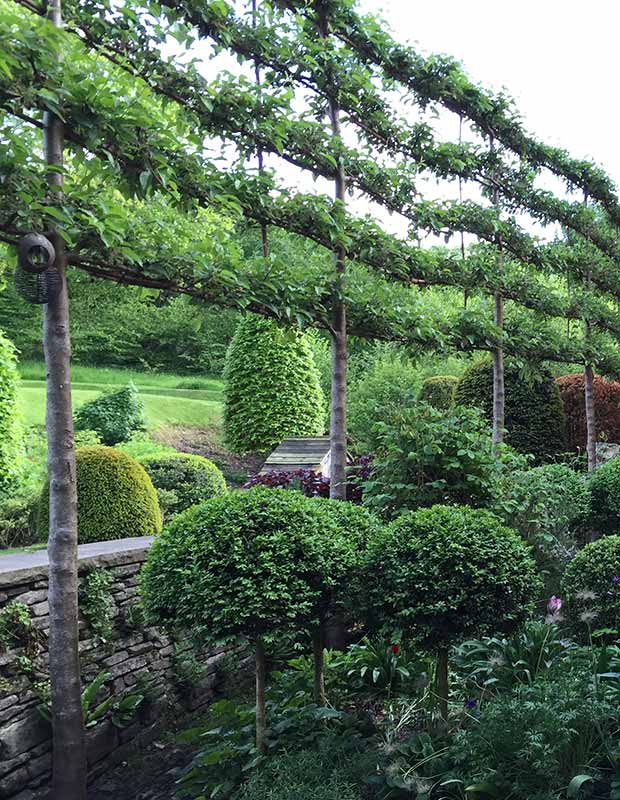
Easily Create privacy with Pleached Fruit Trees.
Pleached, Espalier, Fan-Trained Trees – What’s The Difference?
There’s always confusion between these different types of trained trees.
- A pleached fruit tree is tall with a single clear trunk and a fruiting square crown.
- An espaliered fruit tree has numerous horizontal branches running from a single central trunk. Espaliered Malus Domestica Royal Gala Apple trees are popular.
- A fan-trained fruit tree has several fanned-out branches. Our fan-trained Pyrus Doyenne de Comice is an RHS AGM-winning pear.
Espaliered and fan-trained fruit trees are centuries-old traditions too because they take up less space than full-on trees in a kitchen garden. The regular spacing between fruiting branches gives fruit enough space and sunshine to ripen, especially if they’re trained against heat-soaked walls.
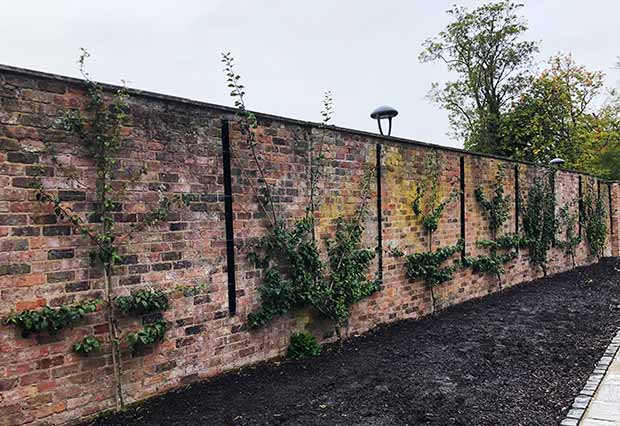
Examples of Espalier and Fan-Trained fruit trees.
Are Pleached Fruit Trees A Nightmare To Maintain?
If you prune pleached trees once a year that’s all that’s necessary. Clip off excess growth in the dormant season and that will keep them tidy. You’ll need a ladder or a long-handled pruning tool to reach. When first planted, and for the first year, give them plenty of water so their roots can get established.
That yearly prune goes for fan-trained and espalier trees too.
Why Are They More Expensive?
Our Pleached trees have years of care and maintenance lavished on them before heading to the saleroom, so they cost more. You’re paying for the time and effort to grow and transform them as well as the tree.
Is it worth it? Yes! Especially if you choose our large maximum impact pleached fruit trees that create instant privacy.
Stars Of The Small Screen
Pleached fruit trees are multi-tasking heroes for large and small gardens. They create privacy, shade, a chic environment, food for wildlife, and tasty fruit for the whole family.
Few other plants create such a dramatic change of scenery in one day yet remain as steadfastly practical.

